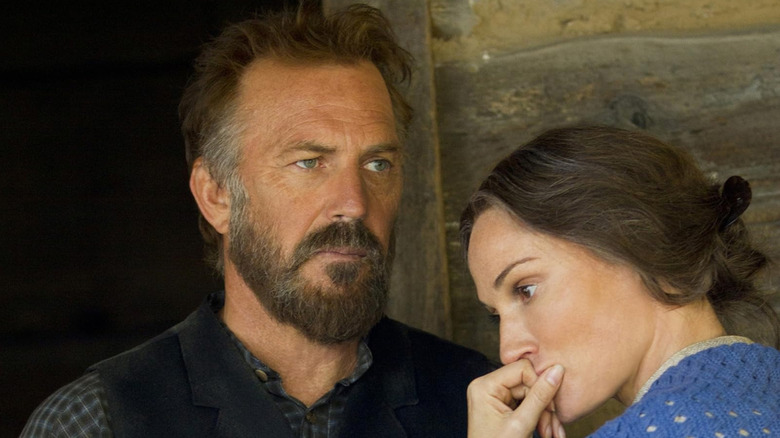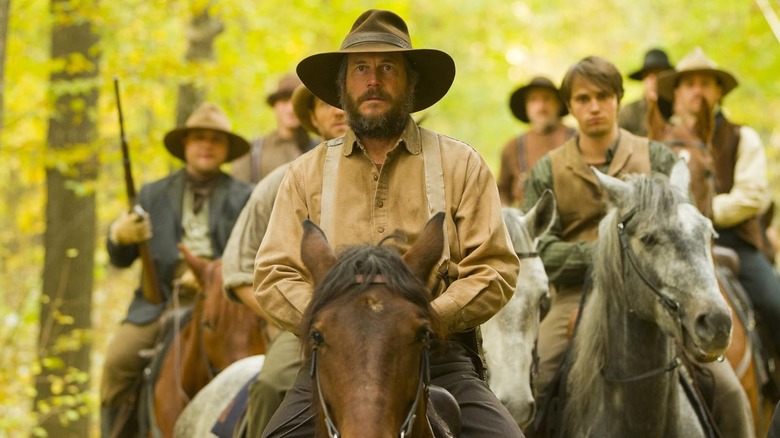
For whatever reason, folks in the film and TV industry seem inclined to hand Kevin Costner a ten-gallon hat and stick him on a horse. Okay, if we’re being real, it’s often the “Dances with Wolves” filmmaker who casts himself to play cowboy, as was also the case when he starred in his own feature-length directorial efforts “Open Range” and “Horizon: An American Saga — Chapter 1.” You can actually trace the “Yellowstone” veteran’s association with the Western genre to the early days of his career when he starred in Lawrence Kasdan’s Oscar-nominated 1985 oater “Silverado.” The duo’s reunion almost a decade later on “Wyatt Earp” didn’t fare as well by comparison, although Costner has always defended the three-hour epic.
Funnily enough, Kasdan’s 1994 feature (which also made the ill-advised move of arriving barely six months after George P. Cosmatos’ gun-slinging, Wyatt Earp-centric classic “Tombstone” hit theaters) isn’t even Costner’s longest sojourn into the Old West. That would be “Hatfields & McCoys,” the three-part 2012 History Channel miniseries that reunited Costner with his “Robin Hood: Prince of Thieves” and “Waterworld” helmsman Kevin Reynolds. In addition to being the project that finally got Reynolds out of director’s jail after 2006’s “Tristan & Isolde” (a period piece that flopped despite having Sir Ridley Scott’s name prominently attached as a producer), the dramatization of the infamous Hatfield–McCoy feud also saw Costner squaring off against another actor who just looks — and sounds — right in a cowboy hat: the late, great Bill Paxton.
Hatfields & McCoys pit Costner against Paxton in a ratings bonanza
Ironically, having become a Western staple, Costner himself was “born in the inner city, in Compton, California,” as he explained to Collider while promoting “Hatfields & McCoys” in a 2012 interview. According to the Oscar-winner, you can draw a straight line between his own personal love of the genre and his experience watching “Jimmy Stewart in a canoe” in John Ford, Henry Hathaway, and George Marshall’s sweeping 1962 Western “How the West Was Won” when he was only seven years old. This, in turn, fed into his love of U.S. history, which is why he knew all about the bloody, vicious, years-long conflict between the Hatfields and McCoys well before signing on for Reynolds’ miniseries.
The actor only continued to research the events that led to William Anderson “Devil Anse” Hatfield and Randolph “Randall” McCoy (who are played by Costner and Paxton in “Hatfields & McCoys”) — and their respective clans — going from dear friends to bitter enemies starting near the conclusion of the U.S. Civil War upon joining the show. Based on his reading, Costner attributed this more to intergenerational trauma and the “incredible anger” in the aftermath of the war than a grudge between the Hatfield and McCoy patriarchs. You can probably trust the man to know what he’s talking about, too, given his meticulous preparation for the role. That extended to selecting the right hat for Devil Anse, a process that Costner assured Collider was “a very big deal.”
Critics were relatively complimentary of “Hatfields & McCoys” (which Costner also produced), though they felt it was a bit too jaw-clenched for its own good. Willa Paskin, writing for Salon, was very much in agreement with this sentiment, writing, “It’s got law and lawlessness duking it out against a backdrop of grime, guts and gravelly voices, but this is all served up humorlessly and laden with self-seriousness.” Be that as it may, viewers turned out in huge numbers to see Costner and Paxton kick dirt in each other’s face, with the miniseries’ premiere becoming the most-watched non-sports telecast in ad-backed cable history at the time and handily setting a record for the History Channel.
Turns out, Kevin Costner and TV Westerns are a dynamite ratings combo — who knew?



Leave a Reply